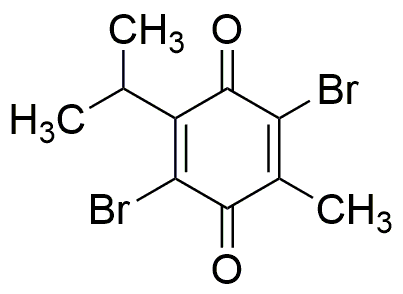2,5-Dibromo-6-isopropyl-3-methyl-1,4-benzoquinone is widely utilized in research focused on:
- Organic Synthesis: This compound serves as a versatile intermediate in the synthesis of various organic molecules, making it valuable for chemists developing new pharmaceuticals or agrochemicals.
- Antioxidant Studies: Researchers explore its properties as a potential antioxidant, which can be beneficial in formulating products aimed at reducing oxidative stress in biological systems.
- Material Science: It is used in the development of novel materials, particularly in the field of organic electronics, where its unique electronic properties can enhance device performance.
- Biological Research: The compound is investigated for its biological activity, including potential antimicrobial and anticancer properties, offering insights for drug discovery.
- Environmental Applications: Its application in environmental chemistry, particularly in the study of pollutant degradation, helps in understanding and mitigating the effects of environmental contaminants.
General Information
Properties
Safety and Regulations
Applications
2,5-Dibromo-6-isopropyl-3-methyl-1,4-benzoquinone is widely utilized in research focused on:
- Organic Synthesis: This compound serves as a versatile intermediate in the synthesis of various organic molecules, making it valuable for chemists developing new pharmaceuticals or agrochemicals.
- Antioxidant Studies: Researchers explore its properties as a potential antioxidant, which can be beneficial in formulating products aimed at reducing oxidative stress in biological systems.
- Material Science: It is used in the development of novel materials, particularly in the field of organic electronics, where its unique electronic properties can enhance device performance.
- Biological Research: The compound is investigated for its biological activity, including potential antimicrobial and anticancer properties, offering insights for drug discovery.
- Environmental Applications: Its application in environmental chemistry, particularly in the study of pollutant degradation, helps in understanding and mitigating the effects of environmental contaminants.
Documents
Safety Data Sheets (SDS)
The SDS provides comprehensive safety information on handling, storage, and disposal of the product.
Product Specification (PS)
The PS provides a comprehensive breakdown of the product’s properties, including chemical composition, physical state, purity, and storage requirements. It also details acceptable quality ranges and the product's intended applications.
Certificates of Analysis (COA)
Search for Certificates of Analysis (COA) by entering the products Lot Number. Lot and Batch Numbers can be found on a product’s label following the words ‘Lot’ or ‘Batch’.
Número de catálogo
Número de lote/lote
Certificates Of Origin (COO)
This COO confirms the country where the product was manufactured, and also details the materials and components used in it and whether it is derived from natural, synthetic, or other specific sources. This certificate may be required for customs, trade, and regulatory compliance.
Número de catálogo
Número de lote/lote
Safety Data Sheets (SDS)
The SDS provides comprehensive safety information on handling, storage, and disposal of the product.
DownloadProduct Specification (PS)
The PS provides a comprehensive breakdown of the product’s properties, including chemical composition, physical state, purity, and storage requirements. It also details acceptable quality ranges and the product's intended applications.
DownloadCertificates of Analysis (COA)
Search for Certificates of Analysis (COA) by entering the products Lot Number. Lot and Batch Numbers can be found on a product’s label following the words ‘Lot’ or ‘Batch’.
Número de catálogo
Número de lote/lote
Certificates Of Origin (COO)
This COO confirms the country where the product was manufactured, and also details the materials and components used in it and whether it is derived from natural, synthetic, or other specific sources. This certificate may be required for customs, trade, and regulatory compliance.


